Dearne District Light Railway
History
The Dearne District Light Railway was long in gestation, but exceptionally short in operation. It was intended to serve the towns and villages of the Dearne Valley, with its extensive coal mines and ancillary industries, which though criss-crossed by numerous railway lines, did not have anything approaching an adequate service provision for passengers, most of whom wanted to travel between the villages and to the nearby towns of Barnsley and Rotherham. The former town had a small tramway system (3.1 miles) operated by the Barnsley and District Electric Traction Company, a subsidiary of the British Electric Traction Company, the latter a larger municipally operated tramway (11.5 miles). Another tramway, operated by the Mexborough and Swinton Tramways Company, a subsidiary of the National Electric Construction Company, made an end-on connection with the Rotherham system, skirting the southern boundary of the Dearne Valley as it made its way to Mexborough. This left the settlements of Wombwell, West Melton, Wath-upon-Dearne, Bolton-upon-Dearne, Goldthorpe, and Thurnscoe in the hands of the railway companies who, unfortunately for the local population, were chiefly interested in goods traffic, or merely passing through on the way to somewhere else.
Although the B&DETCo was initially interested in extending its system, which had been opened on the 31st October 1902, it seems to have quickly grown lukewarm to the idea. Five years later, a scheme for a tramway between Barnsley and Doncaster was proposed — with the support of the local authorities — though various requirements and objections eventually led to it being dropped.
The next attempt to penetrate the area came in 1911 from the M&STCo, which was keen to create a network of trackless trolley (trolleybuses) routes, these no doubt being preferred to trams due to the much lower infrastructure costs, not to mention the MSTCo's recent and painful experience of the surface-contact system it had chosen to use when it opened its tramway in 1907. By this time, however, the local councils — Wath-upon-Dearne, Wombwell, Bolton-upon-Dearne and Thurnscoe Urban District Councils — had decided against having a company controlling local road transport; they therefore acted together to thwart the M&STCo's plans, the powers that the company eventually obtained (in 1914) being significantly diluted. Around the same time, the B&DETCo re-entered the arena, firstly by introducing motorbus services (on the 3rd May 1913), and secondly by reviving proposals for an eastwards extension of its system, though this time using trackless trolleys rather than trams. Like those of the M&STCo, the B&DETCo's trackless trolley plans were strenuously resisted by the four councils.which by this time had decided to apply for powers to operate their own trackless trolley system.
After consultation with Leeds and Bradford Corporations, both of whom had hands-on experience of early trolleybus operation, the councils (plus Darfield UDC initially) rather surprisingly elected to build a tramway, applying for a Light Railway Order in November 1913. Despite strong opposition from the railway companies, as well as council ratepayers and the two tramway companies, the order was eventually part confirmed in 1915. There, however, matters rested, the Great War preventing any further progress.
After the war, an amendment order was submitted in November 1919, which amongst other things, allowed the councils to abandon some of the lines in the 1915 order; this was confirmed on the 18th July 1921.
By this time, even with post-war inflation having settled somewhat, the whole scheme was costed at nearly £300,000, an extraordinarily large sum for four UDCs. Unsurprisingly, dissent now appeared in the ranks of the councils (not to mention their ratepayers), but as three of them (Wath, Bolton and Thurnscoe) were in the process of implementing a combined municipal electric supply system, which the new tramway would use, they ploughed on regardless.
Construction commenced on the 11th May 1923, most of the system opening over a year later on the 10th July 1924, with the last portion, from Wath-upon-Dearne to the Woodman Inn in Swinton, which had required another order, opening on the 29th September. The system was in fact the last first-generation electric tramway to be opened in the British Isles, and was operated — by the Dearne District Light Railway Committee — using 30 brand-new trams, which turned out to be yet another example of optimism overcoming common sense, the system only ever requiring half that number.
The system was 14.18 miles long, and comprised a long main line (single line and passing loops, with only a modest amount of double track) running southeastwards from Barnsley through Stairfoot, Wombwell, and West Melton to Wath-upon Dearne, whereupon it turned northeastwards through Bolton-upon-Dearne and Goldthorpe to a terminus in Thurnscoe. Two branches joined the main line at Wath-upon-Dearne, one having run northwards from a junction with the M&STCo at the Woodman Inn in Swinton, and the other westwards, ostensibly from Manvers Main, though it ended well short of that settlement, and on the wrong side of several railway lines. Although there were powers for other lines, these were not proceeded with.
By the time of the opening, the area was already being served by a number of motorbus operators, not least amongst them the B&DETCo, which had been renamed the Barnsley and District Traction Company in June 1919. The latter was not exactly well-disposed to the councils, who had not only opposed its expansion plans in favour of their own, but one of which (Wombwell) now refused to renew the company's motorbus operating licences, a decision which ended up being escalated to the Ministry of Transport. Crucially, there was no physical connection between the two tramways, DDLR passengers having to change trams in order to reach Barnsley town centre, whereas the competing company buses continued right through. At the other end of the system, although a connection was made to the M&STCo tracks at the Woodman Inn, through services, operated by the antiquated trams of the company, only started in 1928, and were not a success.
The contest between an expensive cross-country tramway and flexible motorbus services was an uneven one from the start, the existing motorbus services being quicker than the trams, sometimes markedly so. During the Light Railway Order hearings in 1914, several experts had predicted that the tramway could not hope to turn a large enough profit to service the loan debt, and so it was to prove. Alarm bells no doubt started to ring loudly in the council offices when the meagre operating profit of the first year was turned into a significant loss by the punishing interest and capital repayments, necessitating a significant call on the rates, a situation that only worsened.
The buses were modern and popular, and even though the fares were artificially higher (following a ruling from the Ministry of Transport designed to afford some protection to the tramway), the public clearly preferred them. In 1927, the DDLR attempted to compete with the B&DTCo motorbuses by lowering fares, to which the company responded in kind, the end result being even bigger losses for the tramway operation. Eventually the councils had to admit defeat, and approached the BETCo to see whether an accommodation could be reached that would put a stop to the ruinous competition. An agreement to share revenues on a 'mileage operated' basis was eventually struck, and this came into operation on the 1st April 1929. By this time, however, the end of electric tramway operation was only a matter of time, the M&STCo having abandoned its tramway just two days beforehand, with the B&DTCo soon following (on the 1st September 1930), having changed its name yet again — to the Yorkshire Traction Company — as a prelude to its motorbus expansion plans.
Despite the agreement with the YTCo, the DDLR still returned an operational loss, and that was before any debt and interest payments were added on. In August 1932, the councils finally decided that enough was enough, agreeing to close the tramway in return for £75,000 and a share of future operational profits — from the YTCo — only around a quarter of what it had cost them just nine years earlier. The last tram ran on the 30th September 1933, services thereafter being provided by YTCo motorbuses.
Uniforms
Motormen and conductors were provided with double-breasted jackets with four pairs of buttons (of unknown pattern) and lapels; the jacket collars were plain, i.e., devoid of insignia. The uniforms were green with red piping. The tensioned-crown peaked caps bore a large, brass, oval cap badge bearing the full system title above an art deco ribbon, with a rose below, which presumably represented the white rose of Yorkshire. In the only example known to me, there is a prominent oval within the ribbon design at the centre of the badge, which is suspiciously empty, raising the possibility that issued examples may have contained an employee number.
Rather than greatcoats, male staff were issued with smart double-breasted overcoats bearing lapels; these coats do not appear to have borne insignia of any kind.
Details of inspectors' uniforms are currently unclear.
Despite the fact that the DDLR operated wholly within the interwar period, it nevertheless employed women in significant numbers, in fact, virtually the entire conducting staff. Although precise details of the uniforms are unclear, female employees definitely wore tailored, double-breasted overcoats bearing lapels, as well as baggy motor caps; the latter bore the standard oval cap badge.
Further reading
For a history of the DDLR, see: 'The Dearne District Light Railways' by C T Goode; self-published (1997).
Images
Motormen and conductors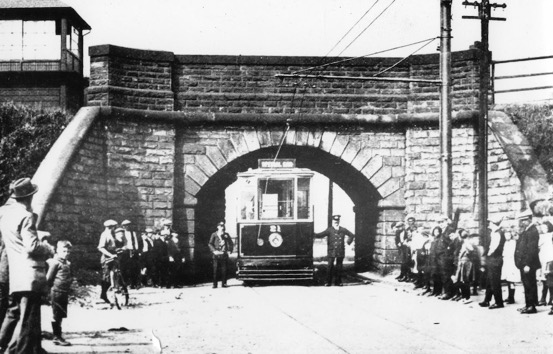
The crew of Tram No 21 pose with their charge under the London, Midland and Scottish Railway's Wath over bridge — photo undated, but given the crowd, probably taken around the time of opening, i.e., July 1924. Author's Collection.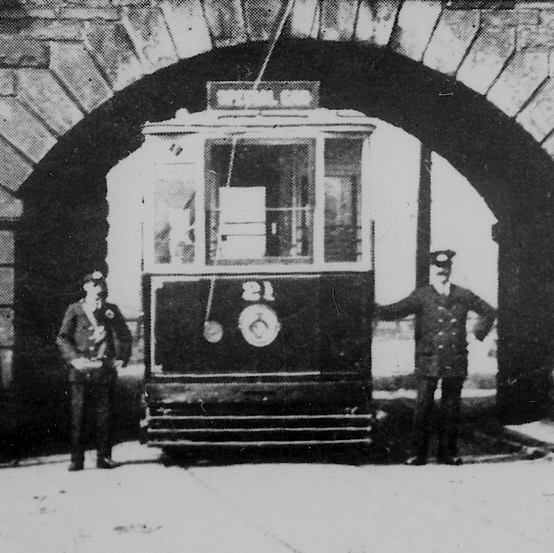
An enlargement of the above photograph showing the crew. Although poorly focused, it does show that a large oval cap badge was worn, almost certainly that shown below.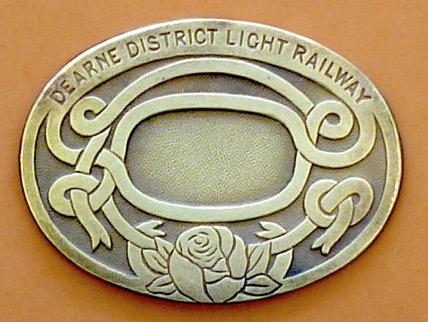
Dearne District Light Railway cap badge — brass. Given the empty space in the centre of the badge, there is a suspicion that this is an unfinished example, and that issued badges may have included an employee number; however, this must await photographic proof.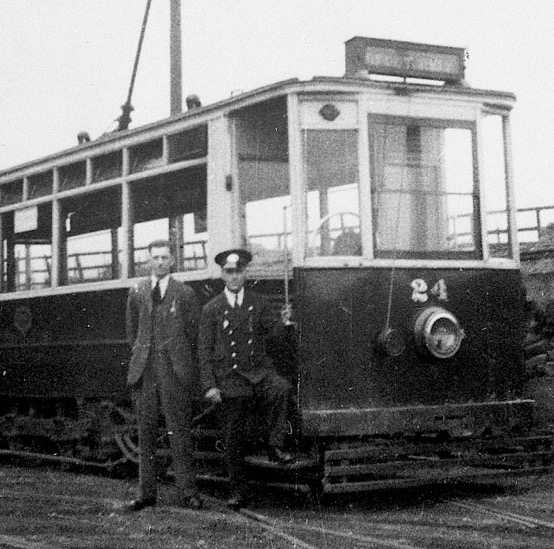
A DDLR motorman (and an unidentified individual, possible an enthusiast) pose for the cameraman at Wombwell with Tramcar No 24 — photo undated. Photo courtesy of the National Tramway Museum. 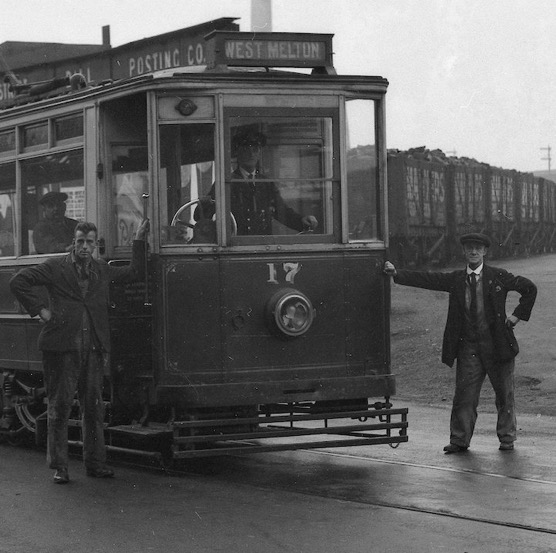
An excellent study of Tramcar No 17 taken at Manvers Main on the 28th September 1933, just two days before closure. Photo courtesy of the National Tramway Museum.
Female staff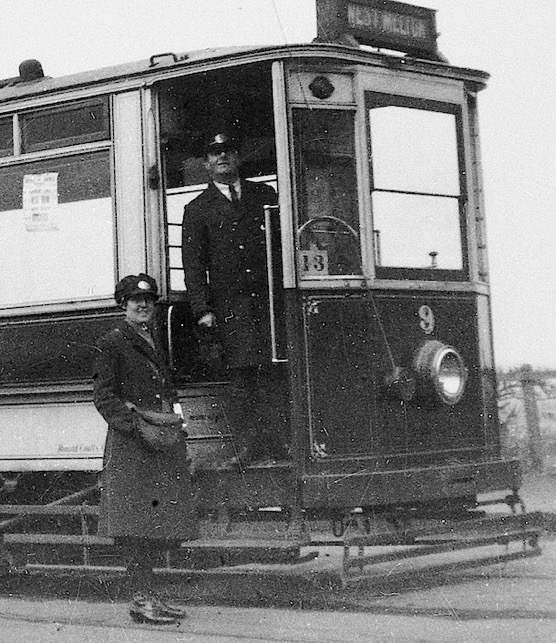
A conductress and a motorman pose for the cameraman with Tramcar No 9 — photo undated. The conductress is wearing a double-breasted top coat along with a baggy motor cap; the latter bears the standard oval DDLR cap badge. Photo courtesy of the National Tramway Museum.